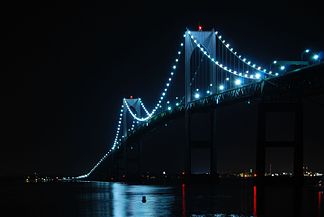
Claiborne Pell Newport Bridge
The Claiborne Pell Bridge, commonly known as the Newport Bridge, is a suspension bridge operated by the Rhode Island Turnpike and Bridge Authority that spans the East Passage of the Narragansett Bay in Rhode Island (northeastern United States). The bridge, part of RI 138, connects the city of Newport on Aquidneck Island and the Town of Jamestown on Conanicut Island, and is named for longtime Rhode Island U.S. senator Claiborne Pell who lived in Newport. The Pell Bridge is in turn connected to the mainland by the Jamestown Verrazzano Bridge.
Newport Bridge
Four lanes of ![]() Route 138
Route 138
Between Jamestown and Newport, Rhode Island
Claiborne Pell Newport Bridge
Rhode Island Turnpike and Bridge Authority
Suspension bridge with deck truss approaches
11,248 ft (3,428 m)
48 ft (15 m)
400 ft (120 m)[1]
1,600 ft (490 m)
206 ft (63 m) at mid-span
June 28, 1969
27,000
Cars $6.00 per car both ways (without an E-Z Pass transponder)[2]
Dimensions[edit]
The main span of the Newport Bridge is 488 metres (1,601 ft), making it the longest suspension bridge in New England. The overall length of the bridge is 3,428 meters (11,247 feet). Its main towers reach 122 meters (400 feet) above the water surface, and the roadway height reaches as high as 66 meters (217 feet).[3] It is four lanes wide, two in each direction. On a clear day, the bridge's towers are visible from the observation plaza at the Gay Head Light in Aquinnah on the Massachusetts island of Martha's Vineyard, from the upper floors of skyscrapers in Providence (approximately 22 miles), and as far northwest as the parking lot of Stone Hill Marketplace in Johnston, RI (approximately 23 miles) and Interstate 295 south in Smithfield north of U.S. Route 44. The Providence skyline is likewise visible from the bridge deck.
Tolls[edit]
The Claiborne Pell Newport Bridge is a toll bridge. As of 2022, the toll is US$4.00 for cars with a non-resident EZ-Pass, and US$6.00 for cars without an EZ-Pass. The toll for Rhode Island residents with an EZ-Pass is US$0.83.[4]
From its opening in 1969 until 2009, the toll could be paid by cash or with tokens, which were purchased at the RIBTA office in Jamestown. E-ZPass was introduced as a toll payment in 2008.[5] Shortly thereafter, the tokens were phased out as a form of toll payment. The final day that tokens were accepted on the bridge was December 31, 2009.[6] Following that date, the only accepted forms of payment were cash or E-ZPass.
Rhode Island residents with a Rhode Island E-ZPass pay a discounted toll of only 83 cents once they sign up for the RIR-RI Resident Discount Plan. Early in 2012, the Authority had voted to raise tolls for passenger vehicles to $5. However, on June 15, 2012, this plan was abolished as Rhode Island lawmakers approved tolls to be added to the newly built Sakonnet River Bridge in the future.[7] The bridge also charges a fee equal to the toll for improperly mounted E-ZPass transponders that require a toll-booth operator to manually raise the gate.[8] Out-of-state residents pay full price, even with a Rhode Island E-ZPass, making this bridge the only toll facility in the U.S. to give a residence discount that isn't limited to the adjacent neighborhoods. The bridge was the only toll road in Rhode Island until August 19, 2013, when the Authority began collecting tolls on the new Sakonnet River Bridge.[9] However, toll collection on that bridge ended on June 20, 2014.[10]
Cash tolling was discontinued on the bridge in October 2021 in favor of all-electronic tolling through EZ-Pass or bill-by-mail.[11]
Bicycles and pedestrians are not permitted on this bridge, but Rhode Island Public Transit Authority bus #64 has bike racks for weekday and Saturday travel.[12]
Impact on the region[edit]
The building of the bridge changed Conanicut Island's lifestyle and economy significantly.[29] Before the bridge, Jamestown was a "summer-resident town" accessible only by ferry on the east passage side and the Jamestown Bridge from the mainland over the west passage, in which one-third of the residents owned summer homes.[29] After the bridge it has become a more wealthy community whose residents now commute to jobs and opportunities in neighboring towns.[29] At the same time, the island's local commerce became more dependent on tourism by visitors from off-island.[29]








